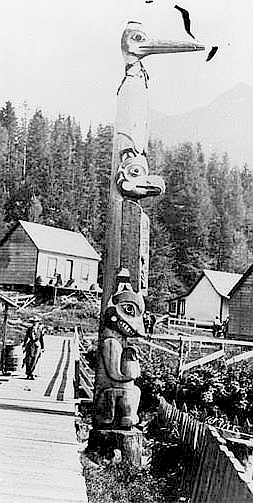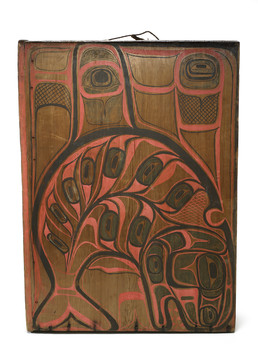Tlingit
Tlingit are an Indigenous people of the Pacific Northwest Coast of North America. Their name for themselves is Lingít, meaning "People of the Tides". The Russian name Колоши (Koloshi) from Alutiiq Kolosxiq also refers to the Tlingit, with this name historically used in the Russian-American period.
History[edit | edit source]
The Tlingit are known for their complex society and rich culture, which include intricate art, totem poles, ceremonial and spiritual practices, and a deep connection to the land and sea. Their traditional territory spans the coastal regions of southeastern Alaska, along with parts of British Columbia and the Yukon in Canada.
Pre-contact Period[edit | edit source]
Before European contact, the Tlingit established a substantial trade network, exchanging goods such as furs, copper, and jade with neighboring tribes. Their society was divided into two main social classes: the elite or nobility and the commoners, with slavery being a part of their social system.
Contact with Europeans[edit | edit source]
The first recorded contact between the Tlingit and Europeans occurred in the late 18th century, with the arrival of Russian explorers. The Tlingit initially resisted Russian efforts to colonize their lands, leading to several conflicts. However, by the early 19th century, the Russians established a presence in the region, impacting the Tlingit through the spread of diseases, trade, and the imposition of the fur trade.
Culture[edit | edit source]
Tlingit culture is deeply rooted in their connection to the land and sea, which is reflected in their mythology, art, and social organization. They are renowned for their woodworking, weaving, and carving skills, particularly in the creation of totem poles, which serve as expressions of family lineage and stories.
Language[edit | edit source]
The Tlingit language is a branch of the Na-Dené language family, with several dialects spoken among the different Tlingit communities. Efforts are ongoing to revitalize the language, which is considered endangered.
Social Structure[edit | edit source]
Tlingit society is matrilineal, meaning that lineage is traced through the mother's line. Clans are the primary social units, each associated with specific animals, spirits, or natural elements, which serve as their crests. These crests are depicted in various forms of art and are central to Tlingit identity.
Contemporary Issues[edit | edit source]
Today, the Tlingit continue to face challenges related to the preservation of their land, rights, culture, and language. They are actively involved in efforts to protect their traditional territories from environmental degradation and to promote the revitalization of their language and cultural practices.
This article is a ethnic-group stub. You can help WikiMD by expanding it!
Search WikiMD
Ad.Tired of being Overweight? Try W8MD's physician weight loss program.
Semaglutide (Ozempic / Wegovy and Tirzepatide (Mounjaro / Zepbound) available.
Advertise on WikiMD
|
WikiMD's Wellness Encyclopedia |
| Let Food Be Thy Medicine Medicine Thy Food - Hippocrates |
Translate this page: - East Asian
中文,
日本,
한국어,
South Asian
हिन्दी,
தமிழ்,
తెలుగు,
Urdu,
ಕನ್ನಡ,
Southeast Asian
Indonesian,
Vietnamese,
Thai,
မြန်မာဘာသာ,
বাংলা
European
español,
Deutsch,
français,
Greek,
português do Brasil,
polski,
română,
русский,
Nederlands,
norsk,
svenska,
suomi,
Italian
Middle Eastern & African
عربى,
Turkish,
Persian,
Hebrew,
Afrikaans,
isiZulu,
Kiswahili,
Other
Bulgarian,
Hungarian,
Czech,
Swedish,
മലയാളം,
मराठी,
ਪੰਜਾਬੀ,
ગુજરાતી,
Portuguese,
Ukrainian
Medical Disclaimer: WikiMD is not a substitute for professional medical advice. The information on WikiMD is provided as an information resource only, may be incorrect, outdated or misleading, and is not to be used or relied on for any diagnostic or treatment purposes. Please consult your health care provider before making any healthcare decisions or for guidance about a specific medical condition. WikiMD expressly disclaims responsibility, and shall have no liability, for any damages, loss, injury, or liability whatsoever suffered as a result of your reliance on the information contained in this site. By visiting this site you agree to the foregoing terms and conditions, which may from time to time be changed or supplemented by WikiMD. If you do not agree to the foregoing terms and conditions, you should not enter or use this site. See full disclaimer.
Credits:Most images are courtesy of Wikimedia commons, and templates, categories Wikipedia, licensed under CC BY SA or similar.
Contributors: Prab R. Tumpati, MD






